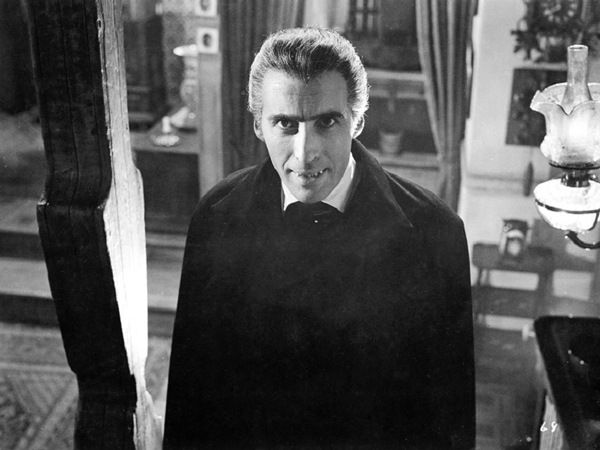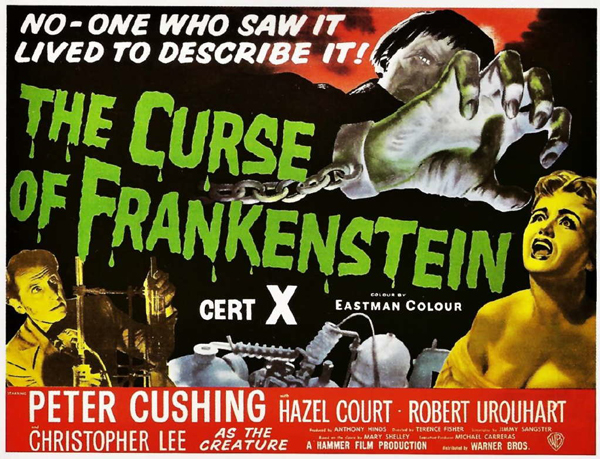Sometimes the best way to know where you’re going is to know where you’ve been. Especially if you’re a vampire.
Settling down in the familiar ground is a necessity for a creature of the night. So, you’d better be well versed in the all the fundamentals. So with that in mind, the Retro division of the Vampire Source is here to remind us all where the coffins are buried. And in doing so, give us a clue why the modern cinema and TV audience loves Edward and Bill so much.
But to do that, I have to to tell you when you ask why the world loves a swinging, sexy vampire, you have to credit….Frankenstein? I hear the collective head scratching going on out there. Just come down this road with with me a minute….
Do you remember the British Invasion? Maybe not, given the date on the calender says 2013, but I’m not talking about Paul Revere’s Redcoats or four guys with bad haircuts. No, I’m referring to the tidal wave of British horror that came about as the brainchild of a B-movie producer named Michael Carreras.
In 1957, Carreras had a dream…. Like most movie producers, that dream was to make a lot of money without spending a lot of money. Carreras had acquired the international rights of the horror stable of characters that Universal Pictures had immortalized in the 30’s and 40’s. At his finger tips were such literary and film greats as Frankenstein and Dracula without the need to tie them to such established (and expensive) stars such as Lugosi and Karloff.
Carreras and his partners in horror, screenwriter Jimmy Sangster and director Terrence Fisher decided they would forge their own vision of the monster greats. A vision steeped in shock, gore and just enough sexual innuendo to make it past the movie rating censors. All on a budget of course.
So how did they go about realizing their grand vision? By making made-for-TV version of of Frankenstein that sank like a rock on both sides of the Atlantic (Bonus scary points if you’ve seen this very obscure not so classic version). TV definitely wasn’t the way to go….Yet.
So, in 1958, the intrepid group of creators, now named Hammer Films, settled on making a full length movie version of Frankenstein, casting two veteran (if relatively unknown) Shakespearian trained actors as the two main characters. Peter Cushing, the older and more polished of the two, would play the role of Victor Frankenstein and would be the ostensible lead of the film. Christopher Lee, the younger and more physically imposing, would be the Creature, mute, hulking and terrifying.
Well, horror-heads, the rest as they say, was history.
The Curse of Frankenstein was a B-movie sensation, in the UK and the USA, both invoking the spirit of the Shelly and Universal classics, while spinning the story into the 20th Century with the type the food-dye gore and lusty servant wenches that the emerging youth movie audience could appreciate.
Carreras, like all movie execs from the beginning of time, knew how to beat a winning formula into the ground. The audience wanted monsters…Check. They wanted blood…Check. They wanted boobs…Check.
So, for Hammer’s next foray into the extreme, they would return Bram Stoker’s Dracula to life with all the modern trimmings. They would also return the same actors that made for success with Frankenstein, this time with Cushing as Van Helsing (Dracula’s eternal foe) and Lee as (you guessed it) the monstrous, nearly dialogue-less Count Dracula.
Set in a nebulous year in the late 1880’s, Horror of Dracula (1959) reprises the Stoker narrative, but establishes a motif that served Hammer well during its heyday. Namely, the audience is already familiar with the whys and wherefores of the characters. No need for flashbacks (which are expensive) or long, narrative sequences which explain stuff (who needs that?) and with as few exteriors as humanly possible (they’ll see it’s really daytime out there!).
Just have everybody scream on cue, snarl and thrash and get as much food dye as you can in the scene. Oh yeah….Some female victims in low cut costumes would work too.
And again, given a more is more (on a budget, of course) attitude, The Horror of Dracula was an even bigger hit, vaulting Cushing and Lee not just into B-movie stardom, but cinema immortality. But, it almost didn’t happen that way…

Lee, who stole the show despite Cushing’s 2-to-1 appearance ratio, was miserable during the shoot, depressed over his lack of screen-time and nearly blinded by bulky contacts that he was forced to wear whenever he was overtaken by the vampiric bloodlust. One of the great pastimes of watching Horror and many of the following Hammer Dracula films is seeing where Lee misses his marks in fight sequences only to see them preserved forever due to Hammer’s strict no reshoot policies. Frankly speaking, when it was over, Lee felt he was done with horror and the character.
In fact, the very next film in the Hammer vampire series, The Brides of Dracula (1960) would be all about the ladies and would star Cushing without nary a hint of Lee. Seemingly true to his word, Lee would not appear again as the Count until 1966’s Dracula: Prince of Darkness which is now considered the best of the Hammer Dracula films.
Despite the fact that they would not work again together in the series until 1972’s Dracula A.D. 1972, Lee and Cushing maintained a strong personal relationship throughout the years, forever linked by their seminal roles together in the early part of Hammer’s history.
Given the shoestring budget and bare-bones screenplay, Horror of Dracula works because Lee, Cushing and all players understand what they are trying to accomplish: giving the audience a thrill. Throw in Hammer’s desire to titillate (never has there been a more appropriate term) and the film even breaks new ground given the response of Lucy and Mina to the vampire’s embrace.
Gone are the swooning damsels of the Universal versions, secretly hoping that Harker or Van Helsing is charging over the hill to save them. No, these gals kinda like what the Count is doing for them. There’s an eagerness to welcome the Count into their chambers each night and each one of his victims in turn becomes a willing participant in the Count’s nefariousness after feeling his bite. The Hammer films extend the orgasmic metaphor of the vampire’s bite to new heights and create a new paradigm for the genre; The “victim” who meets the monster halfway.
So, yes, Bella and Sookie have some British grandmothers out there. Ladies who come more center stage in films like the aforementioned The Brides of Dracula, along with Taste the Blood of Dracula(1970) and Count Dracula and His Vampire Bride (1972). Women who reminds us that vampires do it better. Creators from Rice to Myers have been mining that undead gold ever since and Hollywood has been more than happy to drive the train. They’ve even figured out that the urban romance audience likes their sexy vampires British, in mannerism if not in accent. Are you listening Robert Pattinson?
So basically, now you know how Frankenstein created sexy vampires. What’s that? I’m mixing my metaphors? Sorry… As Igor would say, occupational hazard.
[dcs_darkspliter size=”large” bottom=”20″]
Horror of Dracula Original Trailer:
Hammer Horror Films on Amazon:

